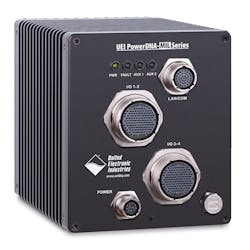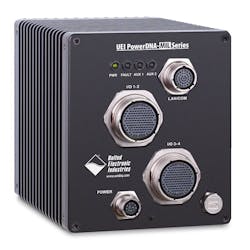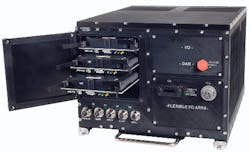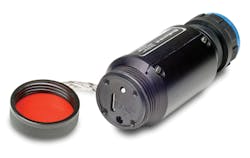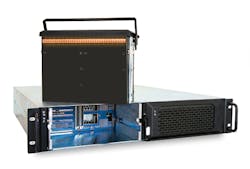Data acquisition devices deliver actionable information in the field
Aerospace engineers and key decision-makers rely on real-time data gleaned from modern DAQ systems to achieve mission success.
By Courtney E. Howard
Myriad missions, both civil and military, in today’s increasingly digital world require data – and, more often than not, real-time data. Access to information is integral to the success of a wide variety of aerospace applications, and places a premium on data acquisition (DAQ) devices.
DAQ systems’ ability to obtain and analyze data enables real-time decision making, affirm industry analysts at Mordor Intelligence in Hyderabad, India. DAQ devices on aerospace platforms deliver critical data to air traffic management (ATM), search and rescue, public safety, firefighting, law enforcement, border patrol, military, research and development, space, and myriad other key officials. Further, DAQ devices provide civil and military pilots with situational awareness for enhanced safety. (For more on the role of DAQ systems in civil and military aerospace applications, click here.)
DAQ equipment also is an invaluable part of a test and measurement toolkit, on which aerospace engineers, systems integrators, and maintenance technicians rely to design and develop, test and certify, as well as maintain, repair, and upgrade aerospace vehicles, systems, components, and payloads. (For more on DAQ for aerospace engineering and test & measurement, click here.)
Global growth
The global DAQ market, valued at $2.26 billion (U.S.) in 2015, is expected to grow at a compound annual growth rate (CAGR) of 6.04 percent and reach $3.03 billion by 2020, according to the company’s global data acquisition market forecast.
“Integrate systems with the flexibility to adapt to program requirement changes with minimal schedule and cost risk,” advises Matt Young, product manager at Curtiss Wright Controls Defense Solutions in Dayton, Ohio.
“Look for systems that provide the most flexibility for encryption, I/O, and storage,” recommends Paul Davis, director of product management at Curtiss-Wright in Dayton, Ohio. “Program requirement often change. The systems need to adapt.”
Technology firms continue to bring DAQ solutions – generally comprising I/O systems, host computers, and software – to market designed to meet this growing demand. “The need for real-time actionable information is expected to drive the market,” Mordor Intelligence analysts say. “Companies are focusing on facilitating user access to data at any time, irrespective of the location.”
A variety of electronics hardware and software solutions are required to deliver critical, real-time data virtually anytime, anywhere, and on any device. Robust DAQ devices start this essential, end-to-end, data-handling workflow, which also includes data processing, information sharing or data communications/transmission, and data storage.
Crucial characteristics
Integration and cooperation are essential in virtually any workflow, and DAQ workflows are no different. Technology firms are, therefore, designing DAQ and data-handing devices with flexibility and interoperability in mind.
“Increased demand for advanced wireless applications is expected to drive the market for DAQ software and hardware in the near term,” industry analysts at Mordor Intelligence in Hyderabad, India, say. Integration of data acquisition systems with cloud and mobile interfaces and technologies will stimulate the demand for these solutions. Mobile and cloud-based data solutions will witness high growth over the forecast period, they add.
Modern aerospace platforms essentially “amount to small data centers that must operate in extremely rugged environments," describes Ed Blackmond, director of software services at Themis Computer in Fremont, Calif.
"Given the need to reduce SWaP, we are seeing tremendous interest in virtualized, hyper-converged environments where compute and storage resources share the same platforms. Rather than a dedicated storage server, these environments employ a virtual machine to aggregate storage from each system and provide shared access to this pool to other virtual machines implementing the application servers.”
Virtually every request Blackmond and his colleagues receive includes virtualized, or private cloud, environments. Customers often run large data-acquisition applications and feed data to "Big Data" processing using Hadoop and similar tools-all running in hyper-converged environments on a common set of hardware, he says.
"Along with the virtualization of compute [tasks], networking and storage are being virtualized," Blackmond explains. "Customers increasingly want to simplify the systems they are deploying, using uniform hardware building blocks." Hyper-converged building blocks are connected via a large network pipe with high bandwidth and low latency. "Sharing resources for compute and data through virtualization allows significantly more to be done with significantly less.”
Demand from end users for faster data-transmission speeds also has led to the migration toward USB- and Ethernet-based data solutions. “The adoption of Ethernet is accelerating with growing confidence around interoperability and ease of integration, which is driving demand for data acquisition hardware and software market,” Mordor Intelligence analysts explain.
Networking needs
“A solid trend we are seeing with air platform integrators is the push to add networked connectivity over Ethernet to their platforms to share on-board sensor data,” says Mike Southworth, product manager for small form factor systems at Curtiss-Wright Defense Solutions in Salt Lake City, Utah. “Ethernet has become the de facto medium for unifying system architecture and enabling situational awareness capabilities, since it is such a well understood and mature technology.
“The demand for data collection is being fueled by mission requirements to improve operational efficiencies and obtain actionable intelligence,” Southworth adds. “Air platforms have much more mobility and capacity to integrate such sensor payloads to collect the data.”
Other factors influencing DAQ adoption and market growth include: changing customer and interoperability requirements, need for faster processing, improved open software standards, cost of implementation, and security issues, analysts say.
Enlisting encryption
"Keeping sensor data secure is becoming more of a requirement as sensor are deployed in hostile environments," Young says. In particular, “the increasing unmanned aerial vehicle (UAV) market and number of vehicles being deployed are growing the need for encryption at various levels.
“With the abundance of unmanned vehicles, we need to meet different encryption requirements,” Young continues. “Unattended operation, where there's not an actual pilot in the plane, requires a whole different level of encryption. If no one is there physically, data needs to be much more secure.” If physical security is insufficient, customers “start to talk about encryption.”
Young is seeing an increase in demand for various types of data-at-rest encryption, and flexibility is key. “Customer are seeking a flexible solution that can be used across platforms. They can change the encryption, input/output (I/O), or storage capacity to meet the different program needs.”
Removable data
Aerospace and defense professionals are approaching Bill Schuh, vice president of sales at Astronics Ballard Technology in Everett, Wash., to meet ruggedized data storage needs related to mission systems and crew reference data.
"Smaller size, less weight, and higher capacity are always in demand," Schuh says. He and his colleagues also see demand for rugged, USB-based mass storage solutions that are portable and provide encryption for data at rest, fast and secure erase functions that can be initiated remotely, and secure data transfer. "Flight plans, targeting details, map data for 3D situational awareness systems, and other relevant mission data can be loaded to the drive, and the data remains secure during transport. When connected, data is loaded to the necessary systems.”
Compact, rugged, and portable data solutions are particularly useful for unmanned aerial vehicles (UAVs), which can have a higher dependency on loaded data, Schuh explains. Complete mission data, including avionics data and video, from a sortie can be recorded securely to the drive; and, upon returning from the mission, the drive can be removed for post-mission analysis and debrief.
High capacity
Given the sheer amount of data being acquired by DAQ systems in air and space, attentions quickly turn to information storage. "There are a lot more sensors out there gathering a lot more data at a lot higher speeds, producing much more data and requiring increased capacities," Young explains.
High-definition still and video cameras, sensors, and electro-optics are producing a lot of data, Davis affirms. "Compression techniques reduce that amount, but they are streaming data constantly; there is this ever-increasing need for more and more storage."
With the advent of DAQ technologies, militaries and other organizations are "putting up an aircraft that rather than being on station for hours is on station for days, commonly referred to as wide-area persistent surveillance," says Amos Deacon III, president of Phoenix International Systems in Orange, Calif. "Along with radar data, they are using video at resolutions that aren't measured in megapixels, but gigapixels – and multiple streams of gigapixel video. That requires a lot of data storage."
Each stream of video data is collecting roughly 20 terabytes (TB) of information over an eight-hour mission. "We've seen a very large increase in the capacity required, and that makes life difficult on an aircraft because the more storage capacity you have, of course, the more weight you have to put on the aircraft and the more space it is going to require," Deacon adds.
Size, weight, and power
Modern and legacy air and space vehicles require the use of data acquisition and data handling devices designed to fit within strict size, weight, and power (SWaP) specifications. A majority of civil and military programs also require the use of rugged electronics systems and components able to withstand various environmental conditions.
"We have seen requirements for much denser packaging of storage devices,” admits Deacon, as well as for the ability to withstand “high altitude and high temperature, not to mention shock and vibration. Hard disk drives don't like to operate in that type of environment, so it is one of the things that are driving the use of solid-state disks. That's where we see data storage requirements going, to solid-state disk, especially for airborne applications.”
Empowering intelligent analytics
Virtually all aerospace and defense applications are driving greater demand for rugged information storage, says Brian Houston, vice president of engineering at Hitachi Data Systems Federal in Reston, Va.
"In the defense space, where the U.S. Department of Defense (DOD) already manages stored data in volumes approaching the exabyte level, there is no question that high-resolution imagery, video, and other disparate forms of data collected from sensors on UAVs, satellites, and manned vehicles present the biggest storage challenge the DOD has ever faced," Houston explains. "While the systems employed in theatre today and tomorrow will give the U.S. military an unprecedented intelligence advantage, the amount of imagery and data that needs to be stored and analyzed demonstrates an enormous challenge from both a budgetary and technical standpoint.
"From a technical standpoint, the military needs storage solutions that can not only store these massive data collects and empower intelligent analytics, but also be operated in the field without the risk of losing valuable data to the elements," Houston says.
Beyond being able to store massive amounts of new information generated daily, agencies need to make sense of it all, Houston says. "By definition, making sense of the data lies at the core of big data.
"Flying a drone and collecting information is merely the first step in the data collection process," Houston says. "In addition to sheer capacity, another critical consideration now and in the future has to do with performance. The images need to be corrected, calibrated, processed, stored, and evaluated efficiently and effectively.
"The military must be able to store and manipulate this data efficiently and cost-effectively for the long term, so information collected on today's battlefield will be readily available to the warfighters of the future," Houston notes. "This is particularly important for ISR and other applications where intelligence is derived from the data itself; thus, the value of a solution increases if it enables processing and analysis to be done more quickly. Doing so reduces the time from collection to action and improves the chances of mission success."
